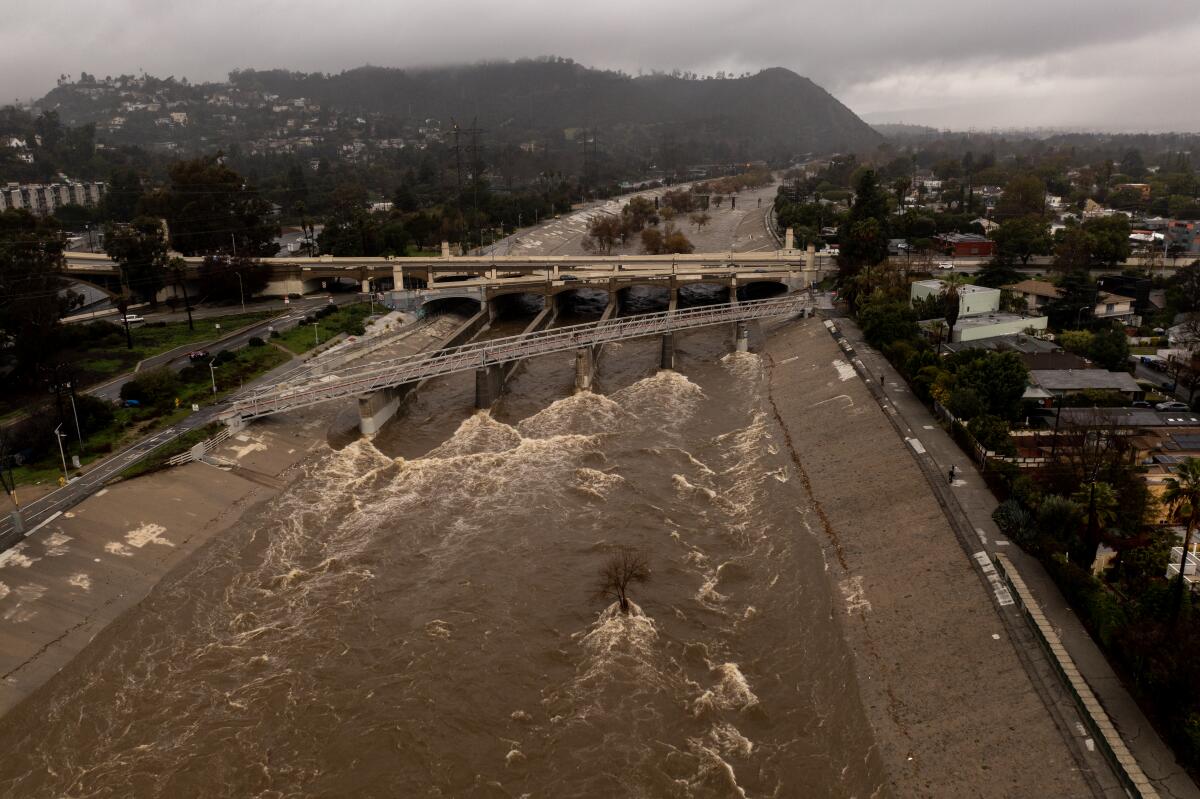Newsletter: Don’t laugh — rain in L.A. can be really scary. Here’s why

- Share via
Good morning. I’m Paul Thornton, and it is Saturday, Feb. 3, 2024. Let’s look back at the week in Opinion.
If you read this newsletter first thing in the morning Saturday and are in Southern California, right now you’re experiencing a brief lull before the next round of storms moves in. Thursday’s weather soaked Los Angeles well enough, but it’s nothing compared to the system bearing down on us right now.
Readers in less temperate climates may scoff at the weather softies in Southern California, but our geography in this part of the world means a few inches of rain in a short period can bring devastation. The coastal L.A. basin and inland valleys are flanked to the north by the San Gabriel and San Bernardino mountains, two of the east-west Transverse Ranges that often wring copious moisture out of storms that may only sprinkle an inch or two of rain over downtown L.A. In his 1998 book “Ecology of Fear,” the late Mike Davis popularized the idea of these steep, quickly eroding mountains portending doom for millions of people living downslope in a strong storm, but the San Gabriels’ inhospitality to human settlement has been known for a long time.
It’s the reason that most of our rivers and streams, which once served as the area’s most important water sources, are now entombed in concrete, shunting water away from our mountains and neighborhoods as quickly as possible. This gets at perhaps the saddest irony of L.A.’s physical development — that the concrete encasing of much of the Los Angeles River and other formerly wild waterways, meant to control flooding in wet weather and make more of Southern California safe for development, is now preventing us from living off the water that falls locally as rain and mountain snow.
So the infrastructure protecting much of Los Angeles in storms such as the one about to hit us is also making the region less climate resilient, because it prevents rain and runoff from recharging natural aquifers. With the benefit of hindsight, I wonder if L.A.’s forefathers really thought their taming of nature wouldn’t come with serious trade-offs.
And, with climate change, those trade-offs and other problems caused by supercharged storms will only become more apparent. As hydroclimatologist Peter Gleick writes in an op-ed article, California is unprepared and needs to build for this new reality:
“Building resilience against extreme weather will take time but that just means we need to work fast. And yes, it will be costly, but spending now to prepare for very wet and very dry seasons will cost far less than having to pay for future disasters. In May, Gov. Newsom proposed nearly half a billion dollars for one-time flood relief, but consistent, long-term funding is needed.
“Atmospheric rivers and bone-dry droughts are like earthquakes and wildfires — challenges Californians have to face. We know they’re coming; we just don’t know exactly when or where. An earthquake-resilient house or a more flood-resilient community won’t stop the ground from shaking or the rain from falling, but it can mean the difference between weathering the storm or cleaning up after a disaster.”
Texas Gov. Greg Abbott is defying a U.S. Supreme Court order. That’s frightening. Texas installed razor wire on portions of the border with Mexico; the federal government, citing its constitutional authority over immigration, wants its agents to remove this wire. The U.S. Supreme Court sided with the latter, which should have put the matter to rest. But it hasn’t, and UC Berkeley School of Law Dean Erwin Chemerinsky warns that this standoff has serious implications for our constitutional order.
Why is L.A. still letting single-family homeowners block solutions to the housing crisis? Fast-tracked affordable housing developments are getting slowed down in parts of Los Angeles thanks to complaints from nearby homeowners, threatening the future of such construction in a city that badly needs new units. This isn’t what solving a housing shortage looks like, says economist Jason Ward: “If we can’t build fully affordable projects that don’t drain government coffers even on the edges of land zoned for single-family residences, then Angelenos should prepare for a permanent housing crisis.”
Homeless in L.A.: Not every life is a “success story,” but everyone deserves dignity. Robert Karron, who teaches English at Santa Monica College, shares the stories of three of his unhoused neighbors in Venice, whose lives reflect the fact that some “aren’t on an upward trajectory and may never be, and those people also deserve respect and dignity.”
Enjoying this newsletter? Consider subscribing to the Los Angeles Times
Your support helps us deliver the news that matters most. Become a subscriber.
That pain in your back? It’s really a pain in your brain. As a chronic pain patient who recently underwent surgery (which, I am glad to say, feels as if it’s been effective), I admit to bristling a bit at this op-ed article. But, Nathaniel Frank makes several good points that were a part of my treatment prior to surgery: The brain processes signals and interprets them as pain, so it’s important to treat it as a mind-body issue as much as a purely physical one.
Throwing soup at the Mona Lisa can help fight climate change. USC environmental studies professor Shannon Gibson says climate activists have grown tired of the slow-moving international negotiations often undermined by fossil-fuel interests. Their highly public displays of civil disobedience, she says, may actually be nudging those frustratingly slow government processes along: “Researchers call this the ‘radical flank effect.’ It was effective for both the civil rights and feminist movements, and it is evident in other political movements in the U.S. today.”
More from this week in opinion
From our columnists
- Robin Abcarian: Need help finding a good book? Try one your 9th-grader isn’t allowed to read
- LZ Granderson: The border crisis is real. That’s why Trump is blocking solutions
- Jackie Calmes: Economists see a “spectacular” economy. Most voters don’t. Can Biden turn that around?
From the op-ed desk
- No more billionaires? We can be more ambitious than that. No one needs more than $20 million
- What my grandma’s California trailer taught me about housing and elder care
- The only way to stop Hamas is to stop Iran from rebuilding it
From the editorial board
- Yes on Proposition 1, a modest step forward on mental health care
- Do Republicans want to secure the border, or help Trump’s presidential campaign?
- U.S. colleges are overusing and underpaying adjunct professors
Letters to the editor
- Anonymous jurors show how Trump has made life more dangerous
- A border security deal is dead because the GOP puts Trump over country
- L.A. streets are deadlier because traffic laws aren’t enforced
Stay in touch.
If you’ve made it this far, you’re the kind of reader who’d benefit from subscribing to our other newsletters and to The Times.
As always, you can share your feedback by emailing me at [email protected].
A cure for the common opinion
Get thought-provoking perspectives with our weekly newsletter.
You may occasionally receive promotional content from the Los Angeles Times.




